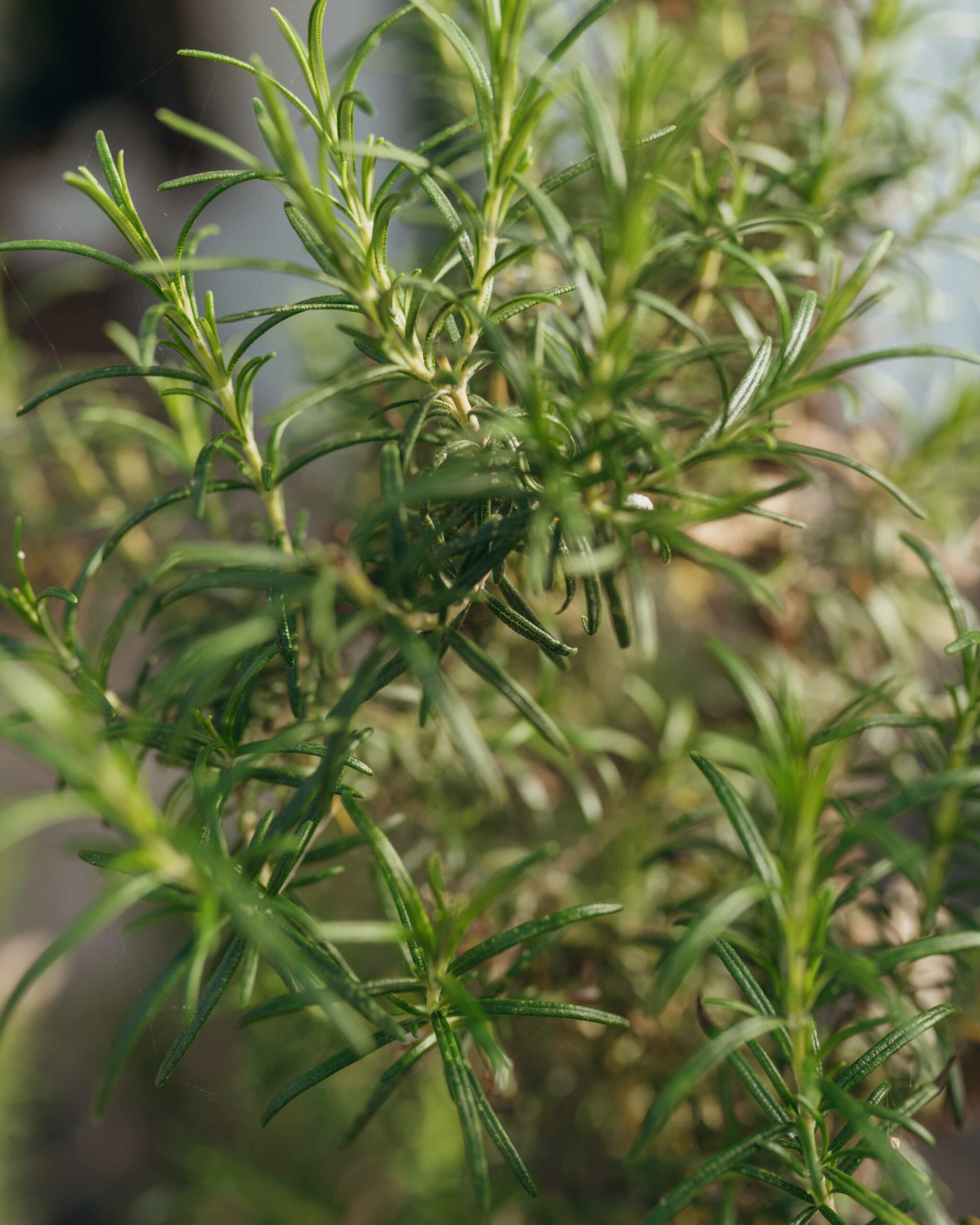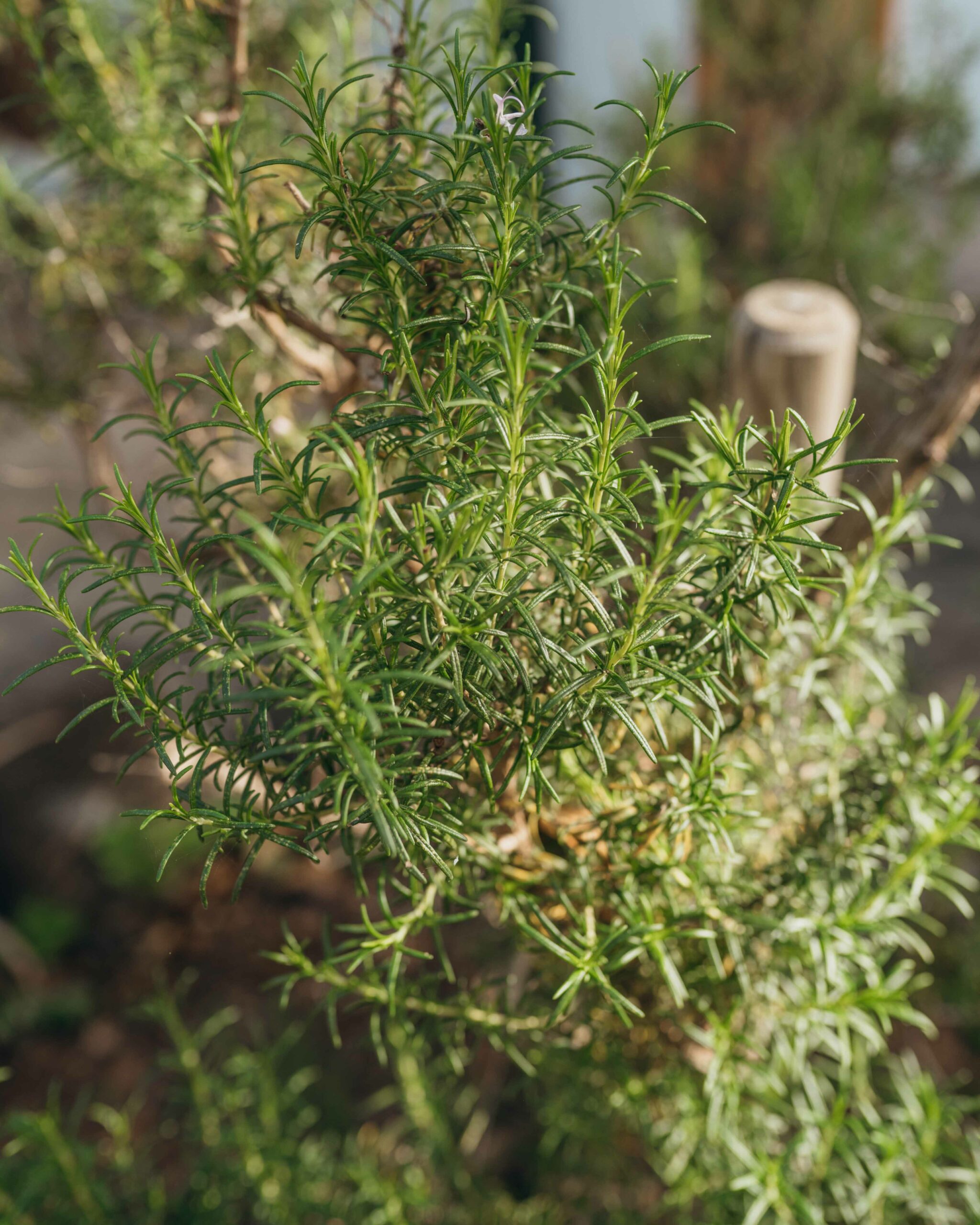Rosmarinus officinalis
Rosmarin
Englische Bezeichnung: Rosemary
Spanische Bezeichnung: Romero
Familie
Lippenblütler (Lamiaceae)
Hauptbestandteile:
Ätherische Öle (einschließlich Borneol, Camphen, Kampfer, Cineol, Limonen und Linalool), Flavonoide, Diterpene, Triterpene, Rosmarinsäure, Vitamin A (Beta-Carotin), Vitamin C und Mineralien wie Calcium, Kalium, Magnesium, Phosphor, Eisen und Zink
Verwendung:
Blätter, Stängel, Blüten
Wirkungsweisen:
-
Kreislaufstimulierendes Mittel
-
Antidepressivum
-
Angstlösend
-
Nervenstärkend
-
Krampfhemmend
-
Gallentreibend
-
Karminativ
-
Antibakteriell
-
Krebshemmend
-
Antimikrobiell
-
Antimykotisch
-
Antiseptisch
-
Antioxidationsmittel
-
Rötungshemmend
-
Schweisstreibend
-
Schmerzstillend
-
Entzündungshemmend
-
harntreibend
-
Menstruationsfördernd
Geschmack:
Scharf, Schwach süß, Bitter (mild)
Energie:
Wärmend, Trocknend, Stimulierend, Wiederherstellend
Ernte-Hinweise:
Pflanze kontinuierlich beschneiden und die Blätter verwenden.
Rosmarin, der schöne „Tau des Meeres“, eine duftende, ozeanische, mediterrane, immergrüne Minze mit aromatischen, kiefernnadelartigen Zweigen.
Rosmarin wird mit der Jungfrau Maria assoziiert, und seine Affinität zum Weiblichen wird auch durch den mittelalterlichen Glauben illustriert, dass Rosmarin, der in Türhöfen wächst, bedeutet, dass eine Frau in diesem Haushalt das Sagen hat.
Rosmarin ist ein anregendes Verdauungstonikum, das hilft, den Magen zu entspannen und zu tonisieren, und ist aufgrund seiner nervenstärkenden Wirkung besonders gut bei Verdauungsbeschwerden, die durch mentale Anspannung, Angst und Sorgen entstehen. Als Cholagogum regt Rosmarin die Produktion von Galle und deren Abfluss aus der Leber an, was die Verdauung anregt und bei der Entgiftung hilft.
Die ätherischen Öle im Rosmarin sind antimikrobiell und schweißtreibend, was Rosmarin zu einem wichtigen Verbündeten bei Erkältungen, Halsschmerzen, Grippe und Husten macht.
Rosmarin ist nicht nur ein Freund des Verdauungssystems, sondern auch des Nerven- und Kreislaufsystems und wird seit langem verwendet, um die Durchblutung des Gehirns zu steigern, was die Konzentration und das Gedächtnis verbessert. Auf diese Weise kann er auch bei Kopfschmerzen, die durch nervöse Anspannung verursacht werden, hilfreich sein.
References:
McIntyre, A., & Boudin, M. (2012). Dispensing with tradition: A practitioner’s guide to using Indian and Western herbs the Ayurvedic way . Great Rissington, UK: Artemis House.
Grieve, M. (1931). A modern herbal . Retrieved from https://botanical.com/botanical/mgmh/mgmh.html
Hoffmann, D. (2003). Medical herbalism: The science and practice of herbal medicine. Rochester, VT: Healing Arts Press.
Family
Lamiaceae
Parts Used:
Aerial parts
Key Constituents:
Volatile oils (including borneol, camphene, camphor, cineole, limonene, and linalool); flavonoids; diterpenes; triterpenes; rosmaricine; rosmarinic acid; vitamin A (beta-carotene); vitamin C; and minerals including calcium, potassium, magnesium, phosphorus, iron, and zinc.
Harvesting Guidelines:
Trim plant on a continuous basis and use leaves
Actions:
-
Circulatory Stimulant
-
Antidepressant
-
Anxiolytic
-
Nervine
-
Antispasmodic
-
Cholagogue
-
Carminative
-
Antibacterial
-
Anticancer
-
Antimicrobial
-
Anti-fungal
-
Antiseptic
-
Antioxidant
-
Rubefacient
-
Diaphoretic
-
Analgesic
-
Anti-inflammatory
-
Diuretic
-
Emmenagogue
Taste:
Pungent
Slightly sweet
Bitter (mild)
Energy:
Warming
Drying
Stimulating
Restorative
Rosemary, the beautiful “dew of the sea,” a fragrant, oceanside, Mediterranean evergreen mint with aromatic pine needle-like branches. Associated with the Virgin Mary, rosemary’s affinity with the feminine is also illustrated by the medieval belief that rosemary growing in door yards signified that a woman ruled the roost in that household.
Rosemary is an uplifting digestive tonic that helps to relax and tone the stomach and is especially good for digestive upset resulting from mental tension, anxiety, and worry due to its nervine action. As a cholagogue, rosemary stimulates the production of bile and its flow from the liver, thus stimulating digestion and aiding in detoxification.
The volatile oils in rosemary are antimicrobial and diaphoretic, making rosemary an important ally for colds, sore throats, the flu, and coughs. It can also help clear congestion when infection does take hold, and rosemary has a long history of use “to dispel the foul air of disease and death” in homes, hospitals, and streets.
A friend not only to the digestive system, but also the nervous and circulatory systems, rosemary has long been used to increase circulation to the brain, improving focus and memory. In this way, it can also be helpful for headaches caused by nervous tension.
Familia
Lamiaceae
Partes aprovechables:
Hojas & gajos
Principales Constituyentes:
Aceites volátiles (como borneol, canfeno, alcanfor, cineol, limoneno y linalol); flavonoides; diterpenos; triterpenos; rosmaricina; ácido rosmarínico; vitamina A (beta-caroteno); vitamina C; y minerales como calcio, potasio, magnesio, fósforo, hierro y zinc.
Indicaciones de Cosecha:
Recorte la planta de forma continua y utilice las hojas
Propiedades:
-
Estimulante circulatorio
-
Antidepresivo
-
Ansiolítico
-
Nervioso
-
Antiespasmódico
-
Colagogo
-
Carminativo
-
Antibacteriano
-
Anticanceroso
-
Antimicrobiano
-
Antifúngico
-
Antiséptico
-
Antioxidante
-
Rubefaciente
-
Diaforético
-
Analgésico
-
Antiinflamatorio
-
Diurético
-
Emenagogo
Sabor:
Picante
Ligeramente dulce
Amargo (suave)
Energía:
Caliente
Secante
Estimulante
Restauradora
El romero, el bello „rocío del mar“, es una fragante menta mediterránea de hoja perenne con ramas aromáticas en forma de aguja de pino. Asociado a la Virgen María, la afinidad del romero con lo femenino también queda ilustrada por la creencia medieval de que el romero que crecía en los patios de las casas significaba que una mujer gobernaba el hogar.
El romero es un tónico digestivo estimulante que ayuda a relajar y tonificar el estómago y es especialmente bueno para las molestias digestivas derivadas de la tensión mental, la ansiedad y las preocupaciones debido a su acción nerviosa. Como colagogo, el romero estimula la producción de bilis y su flujo desde el hígado, estimulando así la digestión y ayudando a la desintoxicación.
Los aceites volátiles del romero son antimicrobianos y diaforéticos, lo que convierte al romero en un importante aliado para los resfriados, los dolores de garganta, la gripe y la tos. También puede ayudar a eliminar la congestión cuando se produce una infección, y el romero tiene una larga historia de uso „para disipar el aire viciado de la enfermedad y la muerte“ en hogares, hospitales y calles.
Amigo no sólo del sistema digestivo, sino también de los sistemas nervioso y circulatorio, el romero se utiliza desde hace tiempo para aumentar la circulación del cerebro, mejorando la concentración y la memoria. De este modo, también puede ser útil para los dolores de cabeza causados por la tensión nerviosa.








































